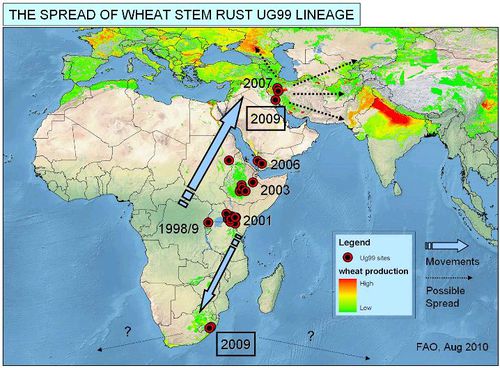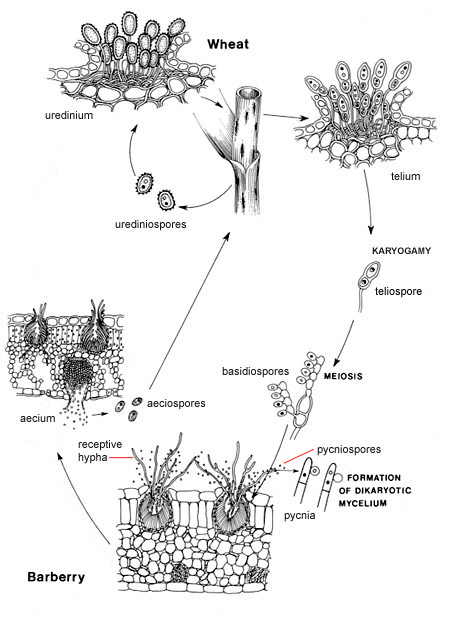Puccinia graminis (Stem wheat rust): Difference between revisions
| Line 18: | Line 18: | ||
===Disease Cycle with Barberry=== | ===Disease Cycle with Barberry=== | ||
[[Image:StemRustdiscycle.jpg|thumb|500px|right|Figure 2: A barberry bush which is a common host for <i>Puccina graminis</i>. http://www.apsnet.org/edcenter/intropp/lessons/fungi/Basidiomycetes/Pages/StemRust.aspx]] | |||
The teliosperes of <i>Puccinia graminis</i> are not able to germinate unless they are exposed to cold temperatures for a substantial amount of time. Due to this fact, the stem wheat disease that includes barberry mostly happens in the temperate regions where the cold temperatures of winter allow the teliospores to germinate (Schumann and Leonard, 2000). Once the growing season is over in the temperate regions, the barberry acts as a host for <i>P. graminis</i>. After the winter is over, the barberry can pass on the disease to wheat. | The teliosperes of <i>Puccinia graminis</i> are not able to germinate unless they are exposed to cold temperatures for a substantial amount of time. Due to this fact, the stem wheat disease that includes barberry mostly happens in the temperate regions where the cold temperatures of winter allow the teliospores to germinate (Schumann and Leonard, 2000). Once the growing season is over in the temperate regions, the barberry acts as a host for <i>P. graminis</i>. After the winter is over, the barberry can pass on the disease to wheat. | ||
Revision as of 00:52, 25 April 2013
Introduction

By Rafael Contreras Rangel
Wheat stem rust, also known as black rust, is caused by the fungus Puccinia graminis and it has recently acquired much attention due to the danger it displays to the global wheat productions in the near future. Although wheat stem rust is not the most common rust disease of wheat rust, with wheat leaf rust being the most common, it certainly currently is the most dangerous (Signh, et al 2008).
Wheat resistance to stem rust was largely believed to be held in the gene Sr31 (Pretorious et al., 2000). But on February 1999, large amounts of stem rust were observed in Uganda’s wheat plantations (2000). After running studies for the resistance in wheat for stem rust, it was found that a new strain of stem rust had mutated, making the resistance to stem rust that was found in Sr31 obsolete. This new strain of stem rust was name Ug99 due to its country of origin and the year it was discovered.
Not only does Ug99 carry virulence to gene Sr31, but overtime it has also mutated to be resistant against most variations of stem wheat rust resistance that originated in wheat itself (Singh et al., 2008). Due to this fact, genetic engineering has started to be employed in order to try and find resistance genes in species closely related to wheat. These genes could then be transferred to wheat and give it resistance against the different variations of Ug99 as well as other different races of wheat rust.
It is extremely important to find a way to stop the expansion of Ug99. Although the exact route of expansion of the Ug99 strain is unknown, models have given it the trajectory to reach India, whose wheat production is one of the highest in the world (Figure 1). It has been estimated that 85% of the global population require wheat as one of their only calorie sources (Singh et al., 2008). If a way to stop the Ug99 strain is not found, one of the world’s largest sources of wheat could be destroyed, and it would bring a major food scarcity problem down with it.
Disease Cycle

Puccinia graminis is an obligate parasite, meaning that it requires living in another organism, benefiting from it while the host organism is usually being stressed or eventually killed in the process. P. graminis is also heteroecious, which means that the fungus requires living in two distantly related species throughout its life cycle. These two distantly related species that stem wheat rust requires are wheat and barberry plants (Schumman and Leonard, 2000). Barberries are a type of shrub that is either deciduous or evergreen, and it can be found in temperate and subtropical regions (Figure 2). While the best mode of reproduction for P. graminis is by completing its life cycle in both wheat and barberry, it can still grow without having to infect the barberry by acquiring aeciospores from other regions (Schumann and Leonard, 2000).
The life cycle of the stem wheat rust starts by the introduction of either an aceciospore or a urediniospore to a wheat plant. The spores can either come from a distant region carried by the wind, from barberry, the alternate host, or from the wheat plant itself if it is already infected. The pathway cycle that the disease will take depends on the region where the wheat is being grown. Temperate regions mostly only grow wheat during the springs since the winters are too cold for wheat to grow. So the plants in temperate regions may either be exposed to aeciospores from barberry or from uredinospores being carried by the wind from the south, where wheat is grown year-round or just at an earlier time than the wheat in the north (Schumann and Leonard, 2000).
Disease Cycle with Barberry

The teliosperes of Puccinia graminis are not able to germinate unless they are exposed to cold temperatures for a substantial amount of time. Due to this fact, the stem wheat disease that includes barberry mostly happens in the temperate regions where the cold temperatures of winter allow the teliospores to germinate (Schumann and Leonard, 2000). Once the growing season is over in the temperate regions, the barberry acts as a host for P. graminis. After the winter is over, the barberry can pass on the disease to wheat.
Towards the end of the growing season, diploid teliospores are produced. Teliospores appear as thick black stripes on the stems of the wheat. Once the winter is over, teliospores then germinate in the spring to haploid basidiospores, which appear to have no color and have really thin walls unlike the teliospores. These haploid basidiospores are the one that infect the barberry (Schumann and Leonard, 2000).
In order to infect the barberry, the basidospores have to germinate and produce haploid mycelium. These haploid myceliums then infect the surface of the leaves of the barberry. Once on the leaves, the haploid mycellims are able to produce Pycnia. Once on this form, the fungus is able to infiltrate the leaf. Inside the leaf, the pycnia produces receptive hyphae and pycniospores. The pycniospores of an individual plant can only be fertilized by the pycniospores of a different host plant (Schumann and Leonard, 2000)
The production of pycniospores is important since it allows cross-fertilization to happen. The pycniospores are spread thanks to the insects that are attracted to the honeydew that is produced alongside the pycniospores. Cross-fertilization between plants produces dykaryotic mycelium. This is one of the most important steps in the life cycle of P. graminis since it allows its transfer from one of its host, the barberry, to the other, wheat (Schumman and Leonard, 2000).
Once the barberry is infected, only a few days have to pass in order for aecium to grow from the dikaryotic mycelium through its leaves. The dikaryotic myselium is able to produce aeciospores, which can infect wheat or other grass hosts. Once the wheat is infected, P. graminis is able to produce another set of dycariotic mycelium, which ultimately is able to produce its own dikaryotic urediniospores (Schumman and Leonard, 2000). The production of these spores can start the “repeating cycle” in crops with favorable conditions since urediniospores can only infect the host plant that produced them (2000). Once the growing season ends, teliospores are formed again on the stem of the wheat in order to start the cycle all over again.
Disease Cycle without Barberry
In North America, the Great Plains are a great example to show how Puccinia graminis spreads without barberry. Since the winter is too cold for the spores to survive, uredinospores from other regions need to be donated. The uredinospores from the warmer Great Plains of the south can then be introduced to the northern Great Plains by northward blowing wind. Since wheat is usually planted on the south earlier than on the north, there always seems to be a fresh batch of spores just waiting to be picked up by the wind. The disease ends once the wheat season of the north is over (Schumman and Leonard, 2000).
It is worth noting that the cycle starts again on the south by having uredinospores that were produced by the wheat planted for the fall infect the wheat seedlings planted for the winter. In the south, P. graminis is able to survive the winter since the temperature is not as cold. The infected winter wheat then infects the summer wheat crops and the spores from those crops eventually find their way north again (Schumman and Leonard, 2000).
Section 2
Include some current research, with at least one figure showing data.
Section 3
Include some current research, with at least one figure showing data.
Conclusion
Overall text length at least 3,000 words, with at least 3 figures.
References
Edited by student of Joan Slonczewski for BIOL 238 Microbiology, 2011, Kenyon College.
